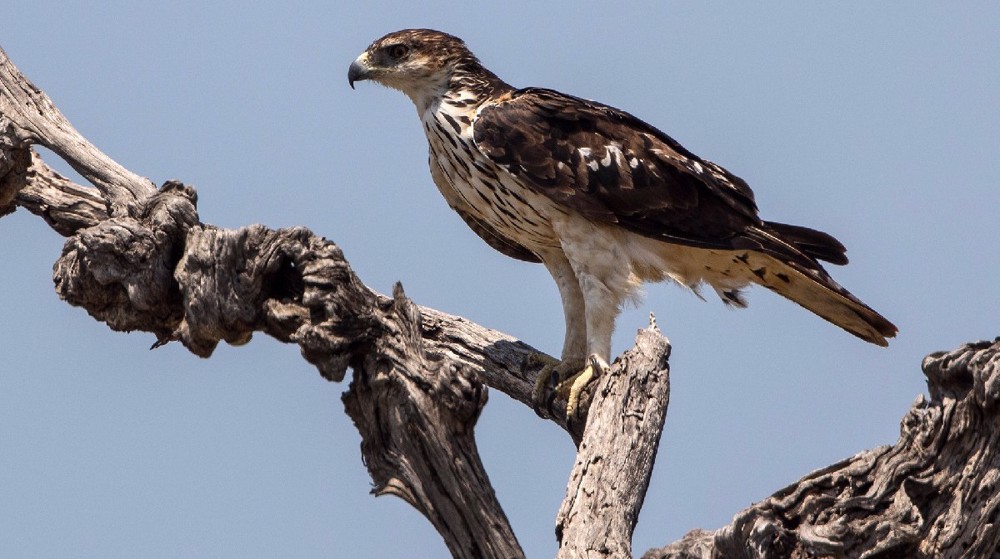Almost all African raptors under threat, study finds
Africa’s birds of prey are experiencing a mass population decline that possesses unforeseen consequences for humans, as 90% of the continent's species is exposed to threat, a new study reveals.
The research published by Nature Ecology & Evolution has warned of dire consequences of human interference as nearly 90% of the 42 raptor species studied are experiencing a tremendous decrease, while more than two-thirds have shown signs of being globally threatened.
According to the data, birds including African hawk-eagle, Long-crested eagle, Wahlberg’s eagle, African harrier-hawk, dark chanting-goshawk, and brown snake eagle declined at rates that could suggest they are now globally threatened.
The study discovered that the African raptors, which can hunt jackals, antelopes, snakes, rodents, and smaller birds, were progressively relying on safeguarded regions like national parks and reserves.
It was also noted in the study that the fall was mostly prominent in West Africa, where agricultural expansions have taken place.
Dr. Phil Shaw from the School of Biology at St Andrews, and a contributor to the study said, that as the human population is about to rise in the coming years, the conservation of these species has become the need of the hour.
“With the human population projected to double in the next 35 years, the need to extend Africa's protected area network...is now greater than ever,” said Dr. Phil Shaw.
While presenting an example to explain the unknown consequences for humans for the decrease of apex raptor species, he said that the decline in Indian vultures in the early 1990s had led to a rise in rabies cases in humans.
“In the case of the vultures, it’s fairly clear cut that they provide an ecosystem service by removing carcasses. We’ve seen what happened in India when they had a similar population crash for different reasons. It led to an increase in the number of feral dogs, particularly in built-up areas … That led to a huge increase among the human population of rabies, passed on by bites from the dogs,” he explained.
Another contributor to the study, Dr. Darcy Ogada said Africa is at the crossroads in terms of saving its magnificent birds of prey.
“In many areas we have watched these species nearly disappear. One of Africa’s most iconic raptors, the secretary bird, is on the brink of extinction,” Ogada added.
“There’s no single threat imperiling these birds, it’s a combination of many human-caused ones, in other words, we are seeing deaths from a thousand cuts.”
Bird expert or ornithologist, Ian Newton has hailed the revelations made by the study, and called it an “important paper”.
“This is an important paper which draws attention to the massive declines in predatory birds which have occurred across much of Africa during recent decades,” Newton was quoted as saying.
"The causes of the declines are many: from habitat destruction to the growing use of poisons by farmers and poachers and expanding powerline networks - all ultimately due to expansions in human numbers, livestock grazing and other activities," Newton added as he went on to discuss the increased human interference in fauna.
"Since the 1970s, extensive areas of forest and savanna have been converted into farmland, while other pressures affecting African raptors have likewise intensified," Dr. Shaw was quoted as saying.
The results of the study are in line with the objective of the Convention on Biological Diversity's COP15, which aims to increase the coverage of conservation areas to 30% of land by 2030.
Over the years, as the human population started hitting its new highs, especially after the industrial revolution, both flora and fauna have seen a spike in human interference that has led to mass extinctions and destruction of thousands of species throughout the globe.
D-8’s role in Iran’s economy after Cairo summit
China slams US as ‘war-addicted’ threat to global security
China ‘firmly opposes’ US military aid to Taiwan
VIDEO | Press TV's News Headlines
President Yoon Suk Yeol to be removed from office
At least 19 Gazans killed by Israeli airstrikes since dawn: Medics
Leader: Iran neither has nor needs proxy forces
US fighter aircraft shot down ‘in friendly fire’ amid aggression on Yemen















 This makes it easy to access the Press TV website
This makes it easy to access the Press TV website